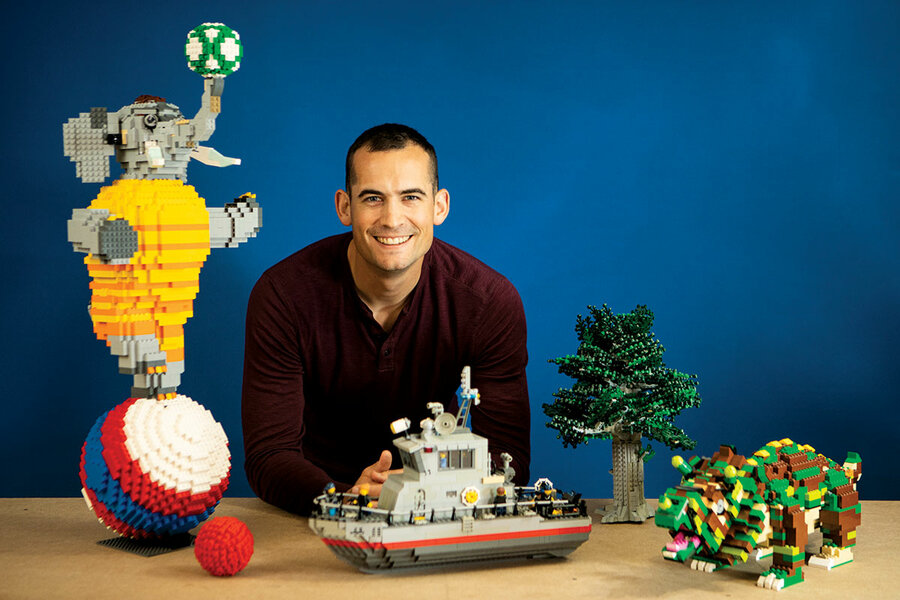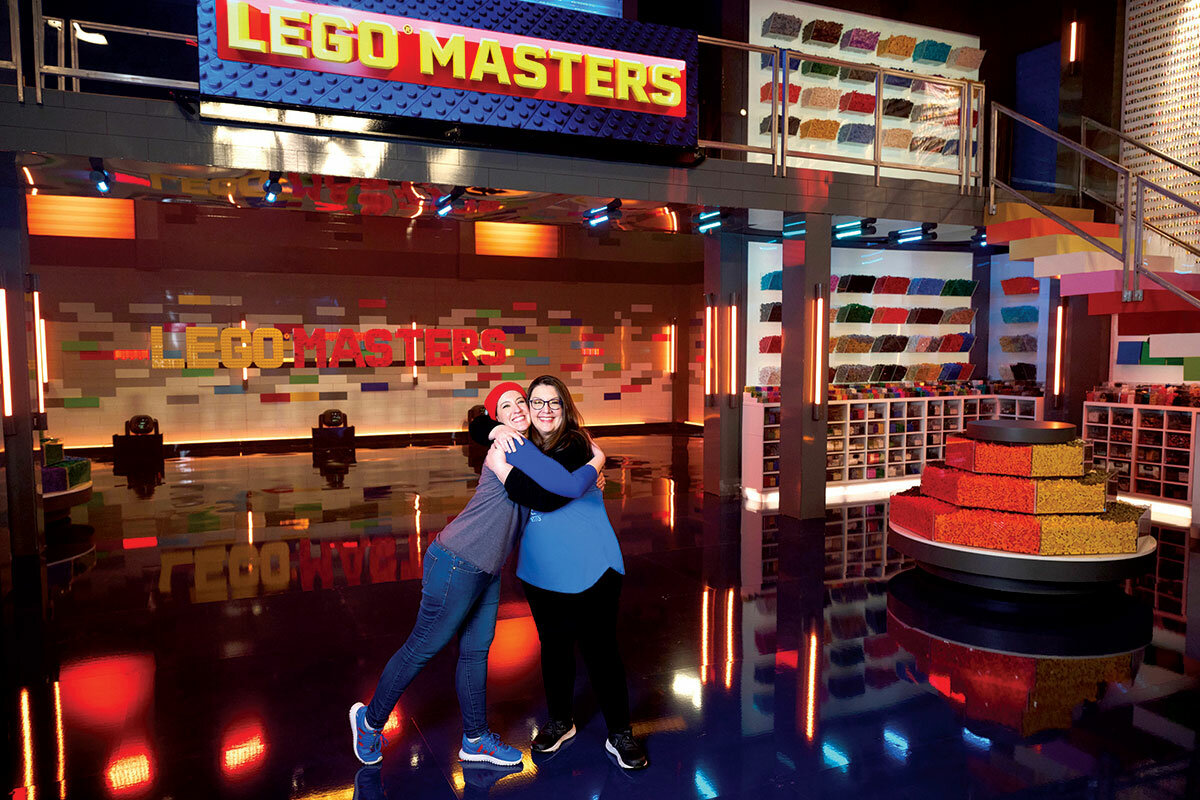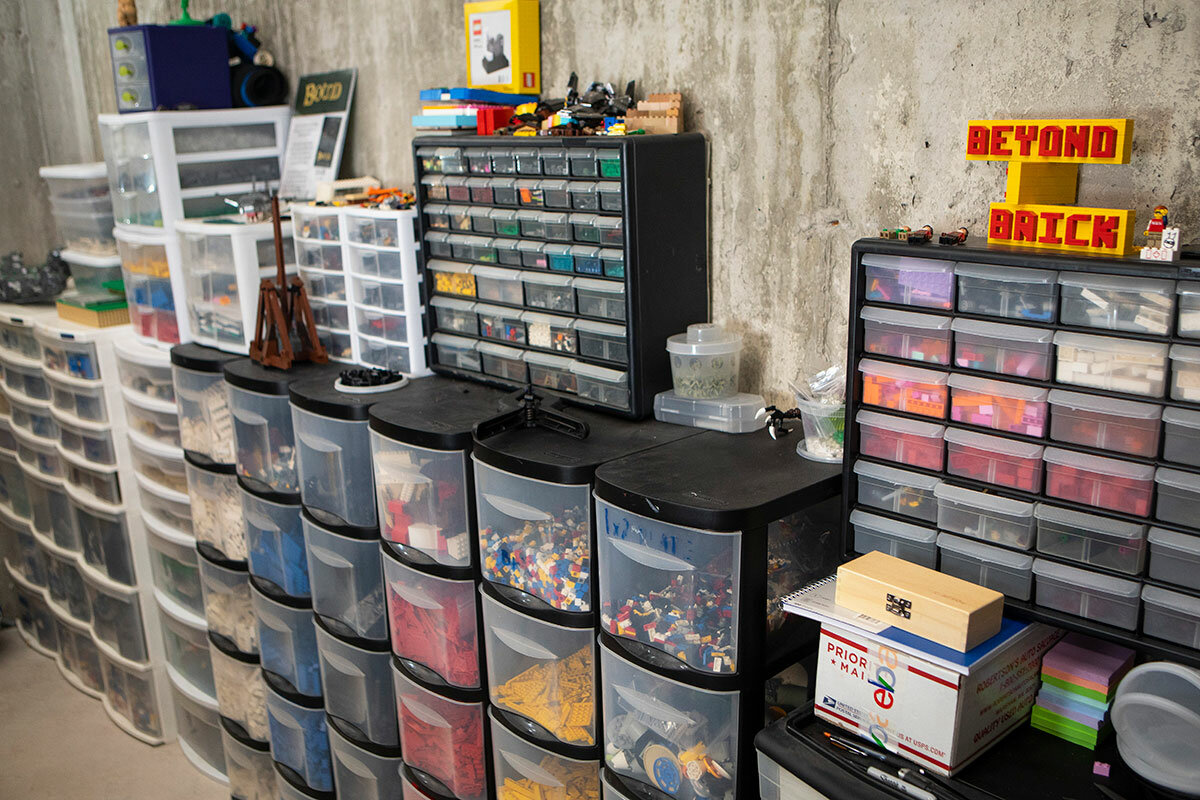First coloring, now Lego. More adults discover their inner child.
Loading...
| Weymouth, Mass.
Greg Tull recently pulled aside his commanding officer for an unusual request. The boatswain’s mate asked for an extended period of leave from his Massachusetts Coast Guard station so that he could play with Lego bricks.
Mr. Tull and his brother Brendan are one of 12 teams competing on the Fox reality series “LEGO Masters,” now in its third season. It’s a similar format to “The Great British Baking Show,” but with plastic pieces instead of baking powder.
Host Will Arnett (the voice of Batman in the Lego movies) challenges the competitors to craft mind-bogglingly complex creations such as dinosaurs, pirate ships, and dogs. “Lego imbues a spirit of play,” says Mr. Tull. “The word in Danish means to play well. ... We take a step back from our standard adult levels of responsibility. And we allow ourselves to be somewhat like a child again.”
Why We Wrote This
A story focused onSeemingly trivial hobbies picked up during the pandemic are helping grown-ups rediscover the joys of play and creativity.
Lego sets aren’t just for kids anymore, if they ever were. Last year, Lego launched an “adults welcome” advertising campaign. Two years ago, the Danish company introduced a line of age 18-plus kits, including a full-scale replica of Thor’s hammer.
But even before the company began explicitly catering to adults, the number of adult fans had been mushrooming. It exemplifies a broader trend of adults recognizing the importance of play.
“It can provide a sense of meaning in life,” says Dave Neale, a researcher in England who studies how play relates to learning and who has been a consultant to the LEGO Foundation. Play “involves both novelty and it involves difference, it involves experimentation, it involves trying things out in a safe context. ... So, connected to that, it can involve creativity because you are freed from the normal kind of boundaries.”
Dr. Neale says there’s been a cultural shift of grown-ups openly embracing play. They now buy coloring books, visit escape rooms, and engage in cosplay at pop culture conventions. But what makes Lego pieces uniquely suited to older generations is their versatility. The toy, developed by a Danish firm that dates back to 1932, has a timeless system. An interlocking plastic Lego brick manufactured in 2022 will seamlessly fit one made in the 1950s.
Yet for decades, the toy was aimed at children. British fan Huw Millington only first became aware of other adult enthusiasts during the primordial era of the internet. In 1997, he founded Brickset.com, a site that catalogs Lego sets and publishes news from correspondents.
“If I had told somebody I played with Lego and run a Lego website in the early 2000s, people would say, ‘What are you doing that for? Playing with a kids’ toy?’” says Mr. Millington. “Well, that has changed.”
Adult perceptions of the toy started to shift with the introduction of themed sets for “Star Wars,” “The Lord of the Rings,” and “Harry Potter.” “The Lego Movie,” a sophisticated comedy released in 2014, supercharged grown-up interest.
“That film has the adult builder character [played by] Will Ferrell,” says Simon Hugo, co-author of “The LEGO Ideas Book.” “It makes huge fun of the adult builder who loses the childhood sense of play.”
Adult fans of Lego bricks are far more visible now. Several countries have their own iterations of the “LEGO Masters” TV show. Brickworld Chicago – one of several annual conventions held around the world – features 100,000 square feet of displays. Celebrity fans such as actors Daniel Radcliffe and Anna Kendrick have enthused about picking up the hobby during the pandemic. “People just took to it, especially during COVID lockdowns,” says Erin Laundry, a contestant on the U.S. version of “LEGO Masters.” “A lot of people who like jigsaw puzzles kind of crossed over to Lego.”
Mr. Tull, the Coast Guard member, owns a quarter-million Lego pieces, organized in plastic containers and labeled drawers in his basement in Weymouth. It’s as colorful as a coral reef. Growing up in a Missouri household of seven children, Mr. Tull didn’t experience what adult fans call “the dark ages.” That’s the period when someone outgrows the toy as a teenager until they come back to it as an adult. “They rediscover that there was an element of play that was missing from their lives and an element of that sort of freedom and creative expression,” says Mr. Tull, a young father whose wife also enjoys building with Lego bricks.
As a teenager, Mr. Tull along with one of his sisters created a stop-motion Lego animation movie that they submitted to a film festival. Now, he’s developing a Lego TV series.
He describes Lego pieces as a medium – one that appeals as much to artists as it does to engineers. “And then you’ll see those two things blended,” he adds. “Someone will build a robot that’s beautiful in design, but also functional from an engineering perspective.”
The world’s biggest toy company has begun releasing products aimed at women, such as flowers made from the bricks (no watering needed). But Lego sets were traditionally geared toward boys. Lego estimates that women only account for about 20% of all adult fans, says Megan Lum, a leader at the Women’s Brick Initiative, an online group dedicated to encouraging more women to take up the hobby. In 2012, the company released a product line for girls called Lego Friends.
“It’s one of Lego’s top-selling lines,” says Ms. Lum. “I think we’ll see a surge in more women building Lego because those ‘Friends’ girls are growing up.”
Ms. Laundry, the “LEGO Masters” competitor, first became a hobbyist in early 2021. For years, she would go to estate sales in search of Lego sets for her husband and son. When the music fan tried building a Beatles “Yellow Submarine” set, she became hooked. She started taking classes on Lego robotics.
“I never thought I could learn about gear ratios or learn how to add motion to builds because, for some reason, I didn’t think I was able to do those things,” she says. “It became a source of self-esteem for me.”
Ms. Laundry met her “LEGO Masters” teammate, Liz Puleo, in an online women’s group. In the first episode of the latest season they built a guitar-shaped spaceship. “I’m a huge fan of continuing play and creativity into adulthood,” she says. “I’m very attracted to the bright, cheerful colors of Lego. It makes me feel happy.”









